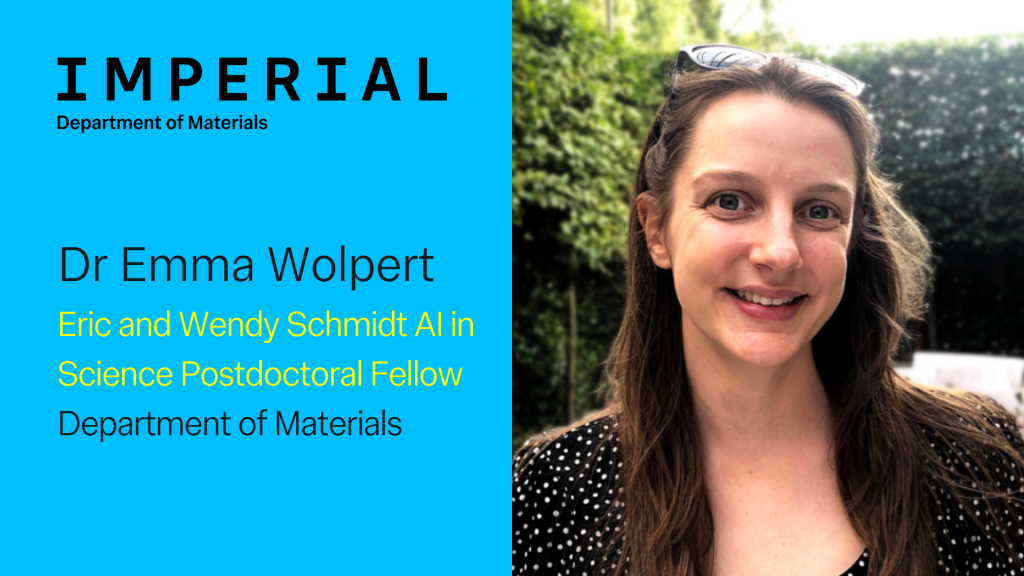
Emma Wolpert is an Eric and Wendy Schmidt AI in Science Postdoctoral Fellow in the Department of Materials. In this new blog post, she explains more about her research into the development of new materials with tailored properties.
What inspired you to become a Materials Scientist?
I’ve always been curious about how everyday objects and technologies work: how a phone battery holds charge, or what makes a material strong yet flexible. At school I loved Chemistry, Physics, and Maths which led me to study Chemistry at university. Over time, I gravitated towards Materials Science because it sits at the intersection of chemistry, physics and engineering, perfectly aligning with my curiosity. It’s a field that blends scientific discovery and understanding with real-world applications, making it both fascinating and deeply rewarding.
How would you explain your research to someone outside the field?
I study how interactions at the nanoscale impact the macroscopic properties of materials. To do this, I develop computational models to predict how small organic molecules come together to form materials. My work focuses on porous materials — where the pores can separate and store gases — and optoelectronic materials, which turn light into electricity. By adjusting these models, I can simulate how changes in a molecule’s shape or interactions influence the overall structure and properties of the material, helping us design materials with specific, desired properties.
Why did you study this area and why is it important?
Understanding how molecules assemble into solid structures is key to creating materials with specific functions. For example, in optoelectronics, the arrangement of molecules can directly affect a device’s performance. I develop techniques to predict the molecular arrangement, which helps us understand how to control the molecular structure and design materials with enhanced capabilities. This is particularly important for developing next-generation technologies, such as more efficient solar cells, where precise molecular control is critical for improving performance.
How could this research make an impact?
My research can lead to the development of new materials with tailored properties — enhancing the efficiency of optoelectronic devices and creating materials that can selectively capture, store, and separate gases. For example, porous materials designed for carbon capture could help reduce greenhouse gas emissions, helping to combat climate change. Similarly, improved optoelectronic materials could lead to more energy-efficient lighting and displays, reducing global energy consumption. By understanding and controlling molecular assembly we can support the design of materials to address some of the world’s most pressing technological and environmental challenges.
Who do you collaborate with at Imperial and beyond?
At Imperial, I collaborate with experimental researchers such as Dr Jess Wade and Professor Sandrine Heutz, who are interested in molecular assembly on surfaces, as well as Dr Becky Greenaway in the Department of Chemistry, who works on porous materials. I also collaborate with computational researchers including Professor Johannes Lischner to investigate the stacking behaviour of layered materials, and Professor Kim Jelfs, where we use AI techniques to analyse datasets. Beyond Imperial, I work with collaborators in the UK (Liverpool and Durham), Germany (Technical University of Munich), USA (Cornell), and Japan (Kyoto).
What do you enjoy most about what you do?
I enjoy uncovering unique behaviour in materials from very simple building blocks and getting to understand why and how different molecular properties affect the material’s overall performance. Analysing data and finding new trends—and then figuring out why they occur—is my favourite part of my job, and it always brings new and exciting challenges.
What do you enjoy outside of research?
Outside the lab, I love getting out of London and going hiking. I’m also an avid traveller and particularly enjoy having the opportunity to travel to international conferences.
What’s something your colleagues would be surprised to learn about you?
My husband and I love a good challenge, so we’ve set ourselves the goal of hiking all the Marilyns in England. These are England’s version of Scotland’s Munros, only much smaller. It’s been a great way to explore hidden parts of the country!